New York City Council unanimously passed the “One LIC Community Plan” on November 12th, a massive redevelopment project for Long Island City in Queens. The plan calls for the construction of nearly 15,000 housing units, with around 4,350 units designated as affordable housing. This initiative also includes over $2 billion in community investments covering education, public housing, parks, and infrastructure improvements, making it the largest single community redevelopment project in New York City in the past 25 years.
Long Island City, one of the fastest-growing neighborhoods in New York City, has attracted significant real estate investments and tech companies in recent years. The approval of this development plan by the City Council is expected to unlock the area’s potential and meet the housing and job needs of local residents.
In addition to the “One LIC Community Plan” in Long Island City, the city government is currently undergoing redevelopment efforts in five communities, including East Bronx, Brooklyn Atlantic Avenue, Midtown South Manhattan, and Jamaica, with the goal of constructing a total of 50,000 new housing units.
The One LIC redevelopment area spans 54 blocks, stretching from Gantry Plaza State Park to Queensbridge Houses, east to Court Square and 23rd Street, and extending to the Long Island City industrial zone.
Council Member Julie Won stated that after lengthy negotiations with the city government, she successfully secured a commitment of $1.97 billion in investments, covering 1,300 new school seats, upgrades to sewage and drainage systems, and a waterfront promenade from Gantry Plaza State Park to Queensbridge Park. Additionally, she obtained an additional $100 million from developers for public uses like art and cultural facilities.
Part of the investment will be directed towards improving infrastructure in Queensbridge Houses, including repairing long-standing leaky pipes, updating community facilities, and renovating vacant residential units. The redevelopment plan is also expected to bring in over $900 million in investments, including the replacement or repair of 80 public housing elevators and underground pipelines.
In terms of parks and public spaces, $95 million is allocated to create new open spaces under Queensboro Bridge, while $30 million will go towards improving Queensbridge Park, including the construction of a new playground, restroom renovations, and lighting upgrades.
To accommodate the anticipated increase in the local population, the redevelopment area will see the construction of two new elementary schools, with a total investment exceeding $300 million. One school is scheduled to open in Hunters Point in September 2027, and the other is expected to open in Court Square in 2028.
“In the past thirty years, urban planning has been dominated by developers. This time, it is the residents who are shaping our future,” said Council Member Julie Won, representing the district. “Through advocacy and community collaboration, we have fought for the resources that Long Island City deserves.”
Deputy Mayor Randy Mastro noted that the recent changes to the city charter will allow for certain affordable housing projects to bypass City Council’s Uniform Land Use Review Procedure (ULURP), expediting the construction process. He emphasized that this reform is integral to the city government’s commitment to accelerating housing development.
Following the approval by the City Council of the One LIC Community Plan, the Mayor has five days to decide whether to sign or veto the plan. For detailed information on the plan, visit https://www.licplan.nyc/

